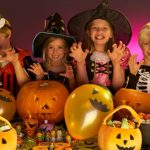All Hallows’ Eve: The Story Behind

Source: nelsoncountygazette.com
Days before fall, Halloween fever was all around the internet. Though there might be certain people who doesn’t celebrate Halloween or even get in the line, we still can’t resist the excitement of the spookiest night of the year. Fancy costumes, make up, and home décor DIYS might have appeared in your Google searches. But, can you tell the story behind the name itself and the celebration as well? Here’s the history of Halloween that deCODE has summarized for you.
Halloween had its beginnings in Christian-Celtic traditions, the Samhain Festival, pronounced “sah-ween”. The Celtic people lived in the area that is now Ireland, the United Kingdom, and northern France about 2,000 years ago. Celts were such a big believer in supernatural things as they lived in ancient time.
The name of Halloween is actually a shortening of All Hallows’ Eve. It traces its roots from All Saints’ Day, also known as All Hallows’ Day. This is a Christian celebration dedicated to the saints. The Eve itself means evening or the night before saints’ celebration.
According to Celtic calendar, Halloween is celebrated on October 31 st , which falls on a Wednesday this year. It marked the end of summer and the harvest, and the beginning of dark and cold winter. Celts believed that Halloween is the boundary between the world of living and the death.
The souls of the dead would return to earth causing trouble, damaging crops, and attacking the living on this date of the year. In order to keep the ghosts away from the living, the old beliefs would dress up in super scary costumes to disguise themselves as demonic spirit. This can explain why most costumes we see on Halloween are on the spooky side.
Celtic people would also sacrifice their animals and crops in honor of the dead. They carried their own torch to the festives and lit it themselves. Furthermore, they gathered together and lit huge bonfires to aid those who have died on their journey. After the festives, people brought the torch back to home and made offerings of food for the ghosts.
As for the trick or treat, those Celtic kids would go around door to door asking for food or money in exchange for prayers right after the festival. The beggers were known as “souling” while the givers were known as “soulers.” Those soulers played a trick such as screwing up the house if no treat is given.
As time went on, this demonic spirit on Halloween in this modern day became a time of fun celebration and pranks. The costumes itself could be anything we imagined, not just the scarry stuff. Halloween also became a day for everyone to wear weird and unique costumes outside the house without fear of being judged by others. So, how about your Halloween?
[tw-button size=”medium” background=”” color=”blue” target=”_blank” link=”http://decode.uai.ac.id/?author=44″]Reporter: Vira Annisa[/tw-button] [tw-button size=”medium” background=”” color=”blue” target=”_blank” link=”http://decode.uai.ac.id/?author=54″]Editor: Karina Clarasaty[/tw-button]
[tw-social icon=”twitter” url=”https://twitter.com/deCODE_Magazine” title=”Follow our Twitter for more Updates!”][/tw-social] [tw-social icon=”instagram” url=”https://www.instagram.com/decodemagazine/” title=”Follow Our Instagram for more Updates!”][/tw-social] [tw-social icon=”facebook” url=”https://www.facebook.com/Decode-Magazine-1895957824048036/?hc_ref=ARQllNXfRdmjk9r__uOAjkB4vJc2ohjO-3fMBz5-Ph_uF74OzCx-zYf-biULGvQzGWk&fref=nf” title=”Follow our facebook for more Updates!”][/tw-social]






